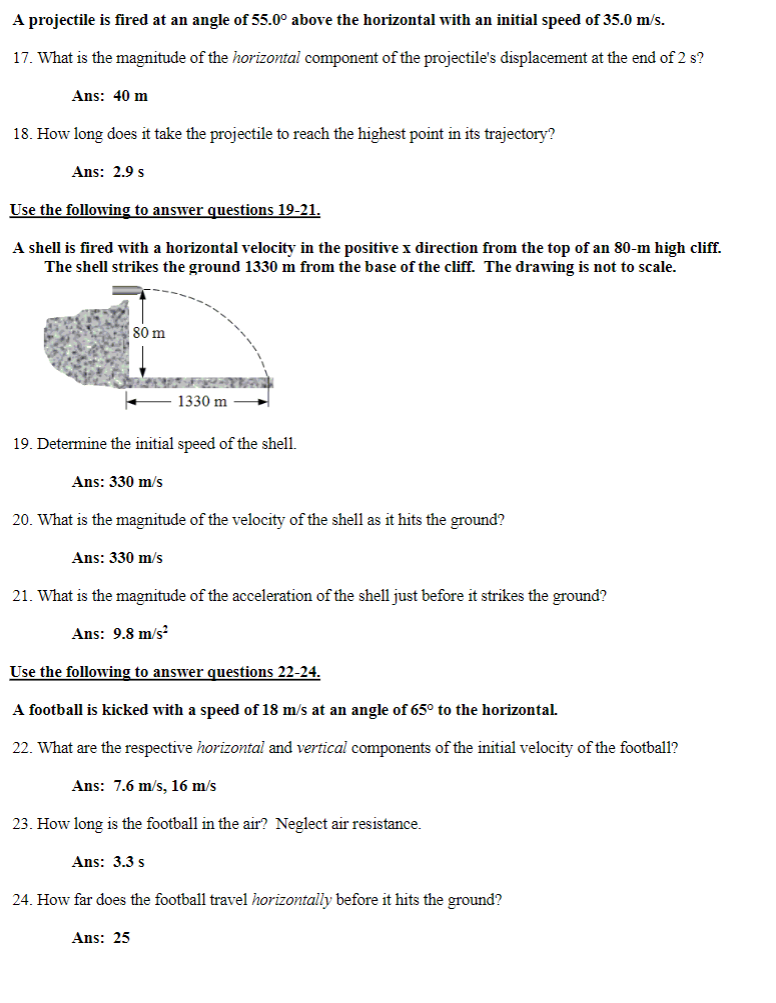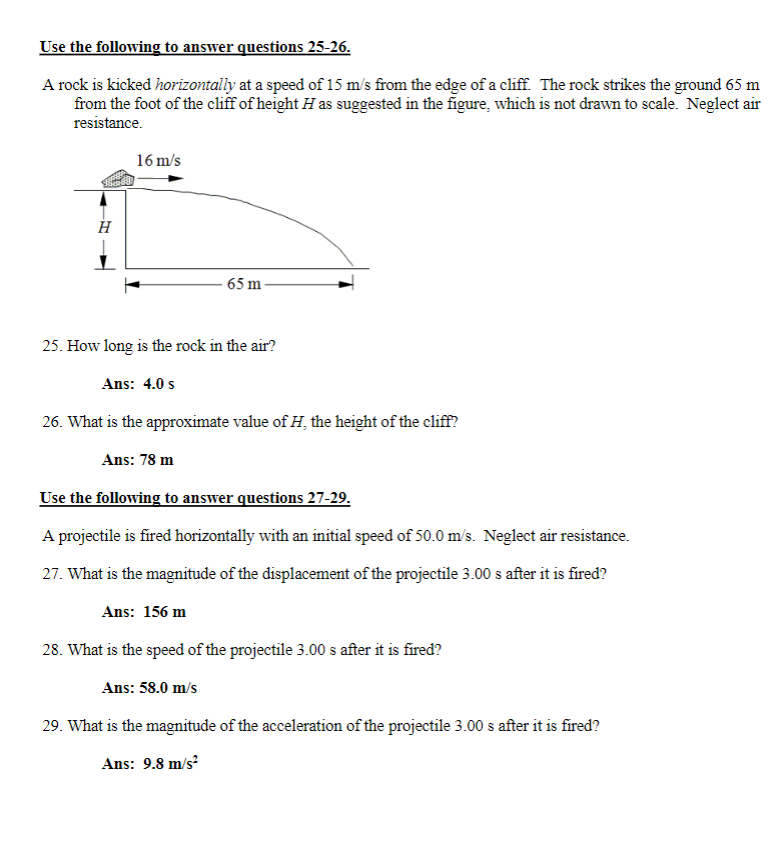A projectile is fired at an angle of 55.0° above the horizontal with an initial speed of 35.0 m/s. 17. What is the magnitude of the horizontal component of the projectile's displacement at the end of 2 s? Ans: 40 m 18. How long does it take the projectile to reach the highest point in its trajectory? Ans: 2.9 s Use the following to answer questions 19-21. A shell is fired with a horizontal velocity in the positive x direction from the top of an 80-m high cliff. The shell strikes the ground 1330 m from the base of the cliff. The drawing is not to scale. 80 m - 1330 m 19. Determine the initial speed of the shell.
A projectile is fired at an angle of 55.0° above the horizontal with an initial speed of 35.0 m/s. 17. What is the magnitude of the horizontal component of the projectile's displacement at the end of 2 s? Ans: 40 m 18. How long does it take the projectile to reach the highest point in its trajectory? Ans: 2.9 s Use the following to answer questions 19-21. A shell is fired with a horizontal velocity in the positive x direction from the top of an 80-m high cliff. The shell strikes the ground 1330 m from the base of the cliff. The drawing is not to scale. 80 m - 1330 m 19. Determine the initial speed of the shell.
Physics for Scientists and Engineers, Technology Update (No access codes included)
9th Edition
ISBN:9781305116399
Author:Raymond A. Serway, John W. Jewett
Publisher:Raymond A. Serway, John W. Jewett
Chapter4: Motion In Two Dimensions
Section: Chapter Questions
Problem 4.60AP: A basketball player is standing on the floor 10.0 m from the basket as in Figure P4.60. The height...
Related questions
Concept explainers
Topic Video
Question
could you walk me through each problem and explain to me how we got to the answer
i would be really greatful if u did your writing explanation on paper:)

Transcribed Image Text:A projectile is fired at an angle of 55.0° above the horizontal with an initial speed of 35.0 m/s.
17. What is the magnitude of the horizontal component of the projectile's displacement at the end of 2 s?
Ans: 40 m
18. How long does it take the projectile to reach the highest point in its trajectory?
Ans: 2.9 s
Use the following to answer questions 19-21.
A shell is fired with a horizontal velocity in the positive x direction from the top of an 80-m high cliff.
The shell strikes the ground 1330 m from the base of the cliff. The drawing is not to scale.
80 m
19. Determine the initial speed of the shell.
Ans: 330 m/s
1330 m
20. What is the magnitude of the velocity of the shell as it hits the ground?
Ans: 330 m/s
21. What is the magnitude of the acceleration of the shell just before it strikes the ground?
Ans: 9.8 m/s²
Use the following to answer questions 22-24.
A football is kicked with a speed of 18 m/s at an angle of 65° to the horizontal.
22. What are the respective horizontal and vertical components of the initial velocity of the football?
Ans: 7.6 m/s, 16 m/s
23. How long is the football in the air? Neglect air resistance.
Ans: 3.3 s
24. How far does the football travel horizontally before it hits the ground?
Ans: 25

Transcribed Image Text:Use the following to answer questions 25-26.
A rock is kicked horizontally at a speed of 15 m/s from the edge of a cliff. The rock strikes the ground 65 m
from the foot of the cliff of height H as suggested in the figure, which is not drawn to scale. Neglect air
resistance.
H
16 m/s
65 m-
25. How long is the rock in the air?
Ans: 4.0 s
26. What is the approximate value of H, the height of the cliff?
Ans: 78 m
Use the following to answer questions 27-29.
A projectile is fired horizontally with an initial speed of 50.0 m/s. Neglect air resistance.
27. What is the magnitude of the displacement of the projectile 3.00 s after it is fired?
Ans: 156 m
28. What is the speed of the projectile 3.00 s after it is fired?
Ans: 58.0 m/s
29. What is the magnitude of the acceleration of the projectile 3.00 s after it is fired?
Ans: 9.8 m/s²
Expert Solution
This question has been solved!
Explore an expertly crafted, step-by-step solution for a thorough understanding of key concepts.
This is a popular solution!
Trending now
This is a popular solution!
Step by step
Solved in 2 steps with 2 images

Knowledge Booster
Learn more about
Need a deep-dive on the concept behind this application? Look no further. Learn more about this topic, physics and related others by exploring similar questions and additional content below.Recommended textbooks for you

Physics for Scientists and Engineers, Technology …
Physics
ISBN:
9781305116399
Author:
Raymond A. Serway, John W. Jewett
Publisher:
Cengage Learning

Principles of Physics: A Calculus-Based Text
Physics
ISBN:
9781133104261
Author:
Raymond A. Serway, John W. Jewett
Publisher:
Cengage Learning

Physics for Scientists and Engineers, Technology …
Physics
ISBN:
9781305116399
Author:
Raymond A. Serway, John W. Jewett
Publisher:
Cengage Learning

Principles of Physics: A Calculus-Based Text
Physics
ISBN:
9781133104261
Author:
Raymond A. Serway, John W. Jewett
Publisher:
Cengage Learning